2006-2007 - Kennedy Space Center Technology Transfer Office
2006-2007 - Kennedy Space Center Technology Transfer Office
2006-2007 - Kennedy Space Center Technology Transfer Office
- No tags were found...
You also want an ePaper? Increase the reach of your titles
YUMPU automatically turns print PDFs into web optimized ePapers that Google loves.
Novel Ice Mitigation Methods<strong>2006</strong> <strong>Center</strong> Director’s Discretionary Fund ProjectAfter the loss of Columbia, there was great concern in the <strong>Space</strong> Shuttle program forPropellant Loading/ the impact of debris against the leading edges of the Orbiter wings. It was quicklyServicing/Storagerecognized that, in addition to impacts by foam, ice that formed on the liquid-oxygenbellows running down the outside of the External Tank could break free during launchand hit this sensitive area. A number of possible solutions were considered, and eventually heaterswere installed in this area. This allowed Shuttle launches to resume, but adding heat to the cryogenicflow system was not an optimal solution. Consequently, the Shuttle program requested that a <strong>Center</strong>Director’s Discretionary Fund (CDDF) project explore possible alternatives.Previously both the Shuttle program and the NASA Engineering and Safety <strong>Center</strong> had fundedextensive efforts for ice mitigation. Many concepts were examined in detail, such as encapsulatingthe area, projecting heat, using flexible insulation, and applying innovative coatings, but all haddrawbacks that prevented them from being used. So it was decided that the CDDF project wouldnot devote resources to concepts that had already been heavily explored, and instead wouldconcentrate on novel ideas that were potentially applicable. Patent and literature searches, as well asbrainstorming sessions, resulted in a number of interesting concepts to be considered.The resulting list of ideas was further filtered to remove ones that, while not considered forDiscovery’s return to flight, were already well developed and understood (for example, electroexpulsiveice removal). In the end, four concepts were chosen for testing and possible development:(1) adding compounds to the ice to affect its hardness, (2) using dark coatings to increase infraredabsorption, (3) using shape memory alloys to break ice free, and (4) applying a high electric fieldwith low-adherence coatings to repel ice.Figure 1. Ice sheet construction involved clamping a sheet of aluminum to aflat, liquid-nitrogen dewar and then spraying the surface with a water mist. Thealuminum sheet had both white and dark surfaces, the idea being that the darksurfaces would absorb more radiation and melt the ice more quickly. In thepicture, radiative heat has been applied to the panel for some time, warmingthe center region of the panel and melting the ice.20 <strong>Space</strong>port Structures and Materials













